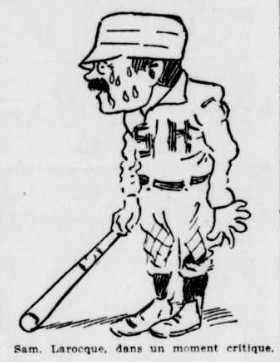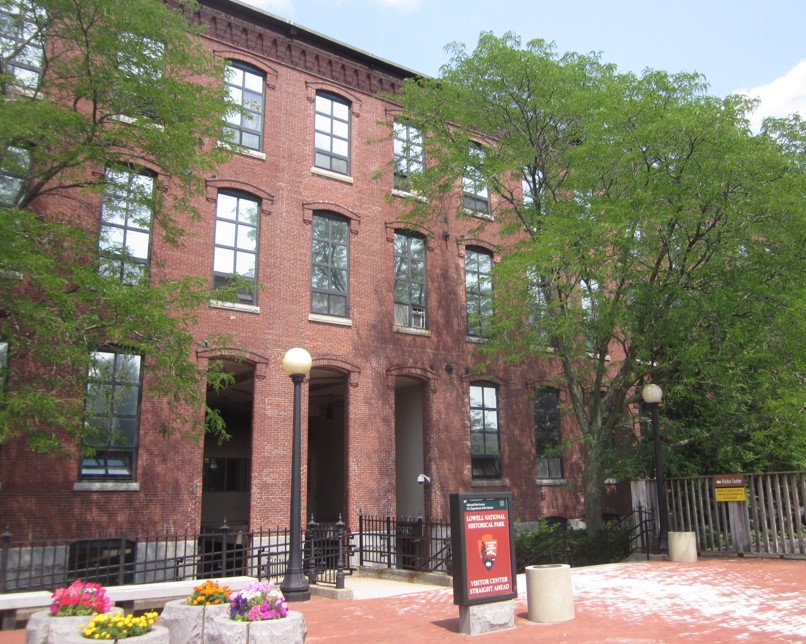Well-worn ruts are as attractive to researchers as they are to travelers. In other words, it can be difficult to break out of established narratives and look at historical issues from a new perspective. This isn’t to imply that old historical writing is bad historical writing, but historians seek to assert the relevance of the past to the present and to produce an ever-more accurate and comprehensive depiction of that past.
The works listed below can help us find a road that is “less traveled by” and that promises to make “all the difference” in our pursuit of the past as it was. Naturally, this list could be five times as long. We may hope, if nothing else, that it will invite readers to explore, beyond the articles, the platforms on which they are hosted, which give a sense of rapidly increasing digital access to scholarship.
Richard S. Sorrell, “Sports and Franco-Americans in Woonsocket, 1870-1930” (Rhode Island History, 1972)
In the field of Franco-American history, Americanization is mostly viewed as anglicization and postwar suburbanization, but it occurred through mass entertainment, union activity, political engagement, war efforts, intermarriage, and sports. A number of these factors have yet to be explored in any particular depth.
Sorrell’s article is worth noting due to the almost inexistent work on the part of sports in Franco history (though we must acknowledge another important article on baseball by Jonathan Gosnell). Sorrell reminds us that there in fact was life beyond churches and factories—and culture was by no means limited to the spirit of survivance. In Woonsocket, starting in the late nineteenth century, baseball was huge. Numerous teams were supported by the Franco-American community.
By 1908 La Tribune featured a daily sports page listing both local and national baseball scores, and in the 1920s the paper was devoting to national baseball coverage almost equal to that of the local English language journal. This is an indication of how immigrant newspapers adapted to the urban American environment in an attempt to retain the reading loyalty of their acculturating subscribers.
We should remember that hall-of-famer Nap Lajoie got his start in Woonsocket. Baseball was also significant enough as to intersect with the Sentinelle controversy (more about that in the article). Franco-Americans also enjoyed boxing and wrestling matches. Interestingly, hockey, seen as the quintessential French-Canadian sport, did not catch on as an organized activity until the 1920s. But all of these sports, Sorrell explains, eased the transition from French-Canadian community life to something that was much more American.

Virgil Benoit, “Gentilly: A French-Canadian Community in the Minnesota Red River Valley” (Minnesota History, 1975)
Benoit’s work has a lens that takes us (helpfully) far beyond New England. It brings out commonalities and differences in the experiences of Franco-Americans in the Midwest and those of compatriots in the Northeast. That type of comparative perspective, often lacking in the field, can shed light on each group.
Benoit recognizes the very real dispossession of Native peoples that made Western colonization possible. A comforting narrative about the happy mingling of Indigenous and French people is at odds with the realities of the late nineteenth-century northern Plains. We also find that at that time French-Canadian emigration to the West was not confined to Manitoba. It was not possible to reach the Prairies by traveling north of Lake Superior until 1885. Those traveling by rail relied on American transportation and it didn’t seem so absurd to stay in northern Minnesota rather than to cross back into Canada. Kinship networks, like rail networks, were essential to such long-distance migration.
The names of the parishioners listed in the 1882 parish census, when compared to those of the 1889 census, reveal that as many as forty-nine families had come and gone from the Gentilly parish [in] this seven-year period. Such figures are, moreover, conservative since in no way can they take into account those who moved in and out of the parish during the period between the two censuses.
By the early twentieth century, French Canadians owned more than half of the land in Gentilly Township. That Petit Canada was perhaps more authentic than those of Lowell and the likes—since it also replicated the rural way of life of most people in Quebec. The community was still served by a bilingual priest in the 1970s.
Many works on the French presence in the West have appeared in the last fifty years. This one stands out as a focused community study that succinctly tackles different aspects of the settlement’s life over the course of generations.
Joseph-André Sénécal, “De ‘Canadiens français aux États-Unis’ à ‘Franco-Américains’: What’s in a name?” (Francophonies d’Amérique, 1992)
The lone French-language piece on this list also has a clear agenda—more on that below. Sénécal’s article studies the competing visions of French Canadians in the United States that were reflected in successive labels applied to them (by them or otherwise). Faith, language, nationality, and race all influenced the terms applied to this group from the beginning of mass emigration to the late twentieth century.
Sénécal addresses the nuances involved in speaking of French people, French Canadians, Canado-Américains, and Franco-Americans. Today we might add “Francophones” to the list. The transition to a new nomenclature for French-heritage peoples at the turn of the twentieth century reflected larger patterns in the community, including a growing rootedness and the stigma associated with Canadianness (which is to say foreignness).
Entre 1890 et 1900, les forces nationalistes constatèrent l’irréparable et la faillite des projets de rapatriement. On commença à parler d’une présence canadienne-française permanente aux États-Unis. En même temps, les grands chefs politiques se mirent à mesurer tout le tort que des liens trop étroits avec l’ancienne mère-patrie ménageaient aux Américains de souche canadienne-française.
As for the agenda, Sénécal argues that the time has come for a new term that represents the group’s North American experience: Québéco-Américains. Some critics might argue that the term Québécois is itself of recent vintage, emerging long after the great migration began, or that Franco-American is too well entrenched to be displaced. That might explain why Sénécal’s proposal, put forth more than thirty years ago, has languished. Either way, his article invites us to think about terminology and consider why Franco-American did catch on—but belatedly, and only in some parts of the country.

Yukari Takai, “Shared Earnings, Unequal Responsibilities: Single French-Canadian Wage-Earning Women in Lowell, Massachusetts, 1900-1920” (Labour/Le Travail, 2001)
To preface this, Takai published a larger work titled Gendered Passages in 2008—one of very few monographs on Franco-American history to be published in the last twenty years. Well, the research note linked here is accessible—at no charge. Takai’s publications represent a major step forward in the study of Franco-American women and complement those of Florence Mae Waldron, which appeared in the same years. We should hope for more work like theirs.
As the title suggests, this article addresses the occupational life of women in a large manufacturing center. At an aggregate level, we know of the significance of female labor to the Northeastern textile industry. But many factors played into women’s labor force participation, including the timing of their entry, the duration of their working years, interruptions, and the type of work performed. Some of the factors were social and familial. Did she live under her parents’ roof? Was one of the parents a widow or a widower? How many siblings did the woman have?
In 1910 and 1920, a significant minority of Canadian-born women came to occupy some of the skilled jobs, such as finisher and folder in textile manufacturing. In 1870, these job categories had been inaccessible for 97 per cent of French-Canadian female workers regardless of birthplace. A good proportion of Canadian-born women in 1910 and 1920 were concentrated in semi-skilled jobs, such as spinners and weavers in the textile industry. Furthermore, a small but growing minority of the Canadian-born worked as inspectors in the textile factories, a position that required a high degree of responsibility, skill, and experience.
Takai paints a complicated picture involving the delayed or upended life cycles that occurred in single-parent households. The weight of domestic work—unpaid but essential—inescapably fell on women and thus affected their marriage and employment prospects. That responsibility was felt most dearly by the oldest siblings and always with a gendered twist.
Leslie Choquette, “French Canadian Immigration to Vermont and New England (1840-1930)” (Vermont History, 2018)
The brevity of Choquette’s article is deceptively straightforward. Not that it misleads readers: rather, one could easily overlook the careful way in which it is framed. It acknowledges the continental nature of the diaspora. It pays attention to overlooked regions, in this case Vermont. It approaches with nuance the factors that led to the migration out of the St. Lawrence River valley. What’s more, we have brief but compelling case studies—real people doing real things. Some of those individuals point to connections between the older fields of migration and industrial cities, connections that researchers may want to parse out.
In Vermont, due to the state’s diverse economy, French Canadians also labored in other economic sectors: the quarries, the railroads, the lumber industry, and the fabrication of wood products—the most important manufacturing industry in the state, producing everything from furniture and appliances to boxes, bowls, musical instruments, toys, and wood novelties.
To editorialize, Choquette points us in a fruitful direction, one that is geographically ambitious, cognizant of diverse Franco-American experiences, complex in its explanations, and aware of developments in adjacent fields. The other articles listed here can similarly serve to inspire researchers and inform more casual readers. The different dimensions of Americanization, regions outside of industrial New England, the challenges of self-definition, and women’s experiences have often been neglected, but there are valuable works that provide a way forward. The whole field of Franco-American history stands to benefit from continued research from these perspectives.
More posts like this one:
- Internet Resources on Franco-American History
- Resources: Monographs and Surveys of Franco-American History
- Resources: Scholarly Journal Articles on Franco-American History
- American History Resources Online
- Canadian History Resources Online
- Internet Resources on Acadian History
- Free Online Books on Franco-American History
Pingback: Friday’s Family History Finds | Empty Branches on the Family Tree
Pingback: This week's crème de la crème - April 22, 2023 - Genealogy à la carteGenealogy à la carte